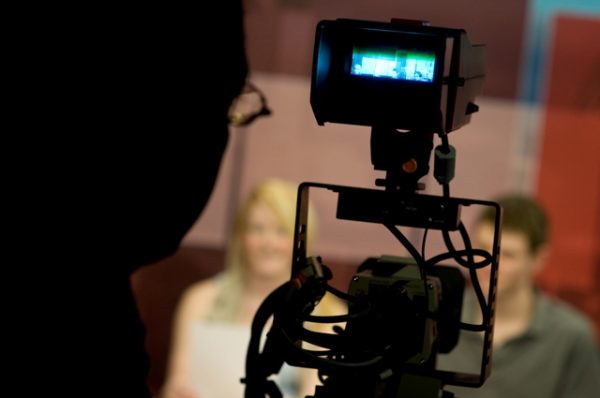FSTV Returns to Campus Circuit of Alternative Media Outlets
Student-run media like The Rival, the paper and FSTV distinguish themselves from Fordham’s Observer and Ram in their use of non-traditional mediums and narrative perspectives. (CITY UNIVERSITY LONDON, SCHOOL OF ARTS VIA FLICKR)
March 14, 2018
Fordham’s media circuit welcomed the return of Fordham Student Television (FSTV) this past semester, adding a broadcast medium to Fordham’s media circuit. FSTV joined a string of alternative media outlets across campus dedicated to bringing news produced by students to Fordham’s general population through multimedia platforms.
Student-run media like The Rival, the paper and FSTV distinguish themselves from Fordham’s Observer and Ram in their use of non-traditional mediums and narrative perspectives. Their reports bring international and local news to Fordham students on entertaining platforms, such as the paper’s scroll-and-click website, and offer production experience specific to their publications.
FSTV is a cross-campus media effort to give students the week’s news through a live video broadcast format. While many campus publications utilize multimedia to some degree, FSTV’s news packages will be Fordham’s only strictly-video source. “We have a fantastic radio station, and we have fantastic print publications, but we don’t have that TV aspect,” said Kelsey Micklas, Fordham College at Rose Hill (FCRH) ’18 and FSTV news editor, on the importance of a well-rounded media lineup. “That broadcasting aspect is so vital, especially in the digital age.”
FSTV aims to begin releasing news packages mid-April, after FSTV writers and producers complete a series of workshops on script writing, reporting and filming taught by faculty trained in broadcast reporting. “Our department is all about theory and practice,” said Dr. Beth Knobel, faculty leader in the revival effort. “You can’t learn journalism without doing journalism.”
As far as subject material, FSTV is currently organizing teams in entertainment, sports and news, along with a sketch comedy group and a dedicated tech team. News hopes to cover both local and international topics that keep Fordham at the center. Subjects include campus activities, neighborhood events in both Manhattan and the Bronx and international stories revolving around matters such as gun control. Ultimately, Knobel said, “it’s up to the students to find stories that they think will be of interest to the community.”
FSTV, like other alternative media outlets, separates their publication from others by contributing a specialized medium of quality to the Fordham media circuit. “We’re not trying to take the place of other publications, but [to] make something unique in and of itself,” said Madeline Johnson, FCRH ’18 and director of content for The Rival.
Generating genuine student interest in news is a staple of The Rival, an online multimedia publication whose mission, Johnson stated, is “making student news interesting.” Fordham’s publication is a chapter of the larger Rival, a multi-campus, national publication stretching across 17 universities from Wisconsin to Connecticut that publishes articles on campus, culture and current news on both local and national levels.
Johnson attributed The Rival’s free voice to its campus-centric approach. “Headquarters” is a team of students and postgraduates working remotely from New York, Charlestown, and D.C. “Since we’re headquartered separately and independently,” Johnson said, “we can do, say and criticize whatever we want,” said Johnson. “The diversity of the interests of our writers is reflected in the diversity of the pieces we put out.”
The Rival takes its role as part of the Fordham community seriously, often using its functions to help larger organizations and generate campus-wide dialogue. For example, a parody of Charli XCX’s “Boys” video raised more than $600 in February for victims of the Dec. 28 Bronx fire, and a launch party complete with a Fordham band and DJ raised over $3,000 for Puerto Rico relief.
The expanse of the Fordham audience also interests the paper, Fordham’s journal of criticism, review and analysis, which publishes articles ranging from Earwax, a music review, to op-eds on modern television series. “Generally, we’re writing for the entire Fordham population” said Editor-in-Chief Claire Nuñez, FCRH ’19. “Our voices on the paper come from so many different walks of life and backgrounds and demographics.”
the paper achieves this diversity by soliciting letters-to-the-editors and guest articles from non-staff writers on a regular basis. This ease of access allows for opinions from all ends of political and social spectrums to reach the paper’s audience side-by-side with opposing viewpoints. Nuñez said this configuration aims to “strike a chord with someone—make people think, make people challenge us [and] challenge their own views.”
“They have a certain approach to issues that resonates with the community,” the paper’s adviser and Senior Vice President for Student Affairs Jeffrey Gray said. “It’s an outlet for students who wish to write through a medium that’s less traditional, less structured than others [on campus].”
All three publications, based at Rose Hill, are attempting to increase their presence on both campuses. FSTV seized its reinstitution as an opportunity to pave the way for cross-campus efforts, grouping Lincoln Center students together to facilitate team organization and travel. Micklas highlighted the importance of inter-campus communication, as she said, “You can’t really tell the Fordham story without people from Lincoln Center.”













